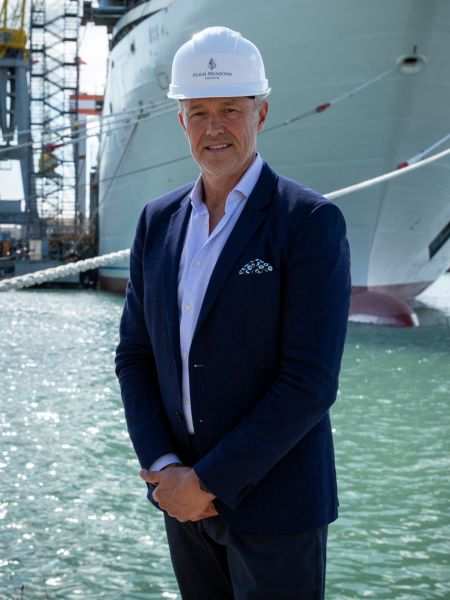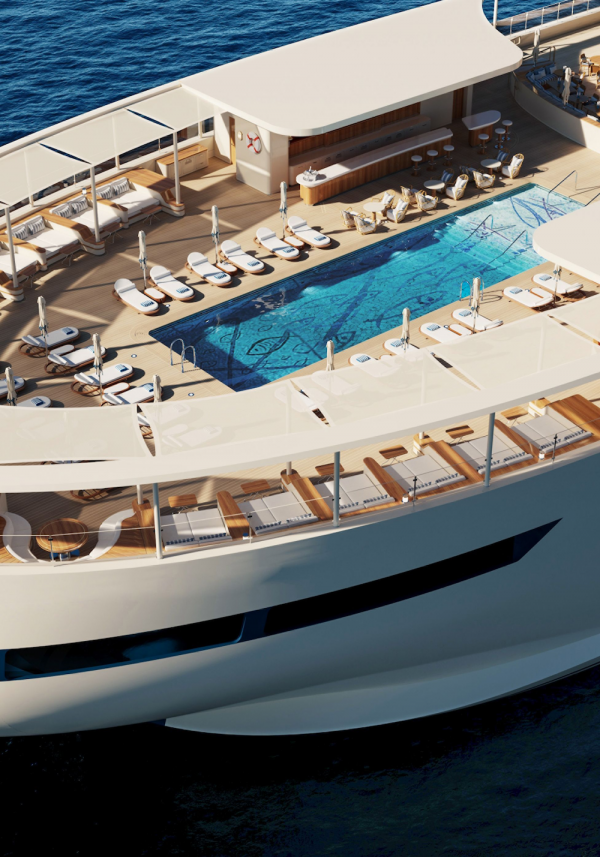
CRUISE - FOUR SEASONS YACHTS POSITIONS FOR LAUNCH WITH STRONG LEADERSHIP AND UPDATED TIMELINE
The prestigious hospitality brand ventures into uncharted waters with its inaugural yacht experience, now set for late Q1 2026.Catégorie : Nouvelles enseignes et affiliations Carrière
Article rédigé par Sonia Taourghi le 11-09-2025
|
 Ben Trodd was appointed as CEO of Four Seasons Yachts in July 2025 - Four Seasons Yachts
Four Seasons I, scheduled to launch in March 2026, represents the brand's most ambitious diversification project to date. The vessel will accommodate 220 guests across 95 suites, with an estimated construction cost of €400 million through Italian shipbuilder Fincantieri. The project faced initial delays, with the launch pushed back from its original late-2025 timeline. The July 2025 appointment of Ben Trodd as CEO follows a leadership gap after former CEO Larry Pimentel's departure in February 2024, highlighting the operational challenges typical of hospitality brands entering new sectors.
Revolutionary design philosophy
Four Seasons I's technical specifications reflect the competitive pressures within the ultra-luxury yacht segment. At 679 feet and 14 decks, the vessel matches similar dimensions to Ritz-Carlton's Evrima but offers 50% more space per passenger according to company statements. The vessel's construction by Fincantieri, in partnership with Tillberg Design of Sweden, follows established patterns in the luxury cruise sector where hotel brands collaborate with experienced maritime specialists.
The vessel's Funnel Suite, spanning 925-square-metre across four levels, represents one of the largest accommodations in the yachting category. However, industry analysts note that such premium suites typically generate disproportionate revenue despite limited inventory. The yacht's connecting suite system, allowing up to 20 rooms to be combined, addresses the multi-generational travel trend that has driven bookings across Four Seasons' terrestrial properties.
The incorporation of a transverse marina, enabling direct sea access, mirrors design elements pioneered by other luxury yacht operators. This feature, activated during dedicated Marina Days, aims to differentiate the Four Seasons experience from traditional cruise offerings, although operational complexities related to weather dependency and port restrictions remain industry-wide challenges.
Expected operational model
The vessel's operational model diverges significantly from traditional cruise economics. Rather than all-inclusive pricing, Four Seasons adopts a hotel-style fee structure with suite rates calculated per accommodation rather than per guest. Food and beverage costs are estimated at approximately €202 per person per day (based on the company's guidance of $250), excluding alcoholic beverages and shore excursions.
This pricing approach reflects broader industry trends, where luxury operators are unbundling services to increase revenue per passenger. Industry sources suggest total voyage costs could reach €15,000-40,000 per suite for week-long itineraries, positioning Four Seasons at the premium end of the luxury cruise market. The vessel's eleven dining venues and L'Oceana Spa represent attempts to maximise onboard spend – a critical revenue stream for cruise operations.
Recruitment and maritime expertise
The enterprise faces significant staffing challenges unique to the maritime luxury sector. To address this, Four Seasons Yachts has established dedicated recruitment channels through its careers platform, targeting hospitality professionals with maritime experience – a limited talent pool given the specialised nature of yacht operations. The company must recruit approximately 210 crew members per vessel, requiring both Four Seasons service standards and maritime certifications.
Industry sources indicate that crew retention remains a persistent challenge in luxury yachting, with seasonal employment patterns and extended contracts at sea creating recruitment difficulties. While the 1:1 guest-to-staff ratio is marketed as exceptional service, it also represents significant operational costs that must be reflected in pricing. To bridge the gap between hospitality excellence and nautical expertise, the company has appointed experienced maritime leader Captain Kate McCue, supported by Captain Duncan Holroyd, whose combined backgrounds include luxury yacht operations.
The success of the staffing model will prove essential, as service quality directly impacts guest satisfaction and repeat bookings in the luxury segment. Four Seasons' established employee training programmes require adaptation for maritime environments, where crew must balance traditional hotel service with safety regulations and space constraints inherent to vessel operations.
Strategic market positioning
The Four Seasons Yachts venture exemplifies the hospitality industry's shift toward alternative revenue streams as traditional hotel markets face growing competition. The partnership with Marc-Henry Cruise Holdings, led by luxury developer Nadim Ashi, follows a joint venture model that allows Four Seasons to leverage its brand without bearing full construction and operational risks.
Ben Trodd's appointment addresses a significant management void, bringing Four Seasons brand expertise after his 25-year tenure with the company. The inaugural season features 32 voyages across Caribbean and Mediterranean routes, targeting destinations inaccessible to larger cruise vessels. However, the vessel's limited capacity of 220 guests constrains total revenue potential compared to larger luxury vessels, placing pressure on per-passenger profitability.
While industry anticipation for Four Seasons' maritime debut has been considerable, the venture's ultimate success will depend on executing the delicate balance between luxury hospitality standards and maritime operations. Early booking patterns and occupancy rates will provide vital indicators of market acceptance for the ultra-luxury pricing model. Whether the considerable industry excitement translates into sustained commercial success remains to be seen, with implications extending beyond Four Seasons to other hospitality brands eyeing similar maritime expansions. The planned second vessel, Four Seasons II, currently scheduled for delivery in late 2026, may hinge on these inaugural performance metrics.
 Travellers will enjoy panoramic ocean views from the pool - Four Seasons Yachts |
|


